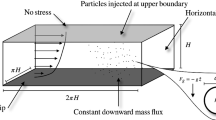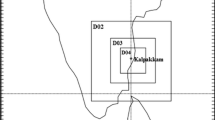Abstract
In many atmospheric flows, a dispersed phase is actively suspended by turbulence, whose competition with gravitational settling ultimately dictates its vertical distribution. Examples of dispersed phases include snow, sea-spray droplets, dust, or sand, where individual elements of much larger density than the surrounding air are carried by turbulent motions after emission from the surface. In cases where the particle is assumed to deviate from local fluid motions only by its gravitational settling (i.e., they are inertialess), traditional flux balances predict a power-law dependence of particle concentration with height. It is unclear, however, how particle inertia influences this relationship, and this question is the focus of this work. Direct numerical simulations are conducted of turbulent open-channel flow, laden with Lagrangian particles of specified inertia; in this way the study focuses on the turbulent transport which occurs in the lowest few meters of the planetary boundary layer, in regions critical for connecting emission fluxes to the fluxes felt by the full-scale boundary layer. Simulations over a wide range of particle Stokes number, while holding the dimensionless settling velocity constant, are performed to understand the role of particle inertia on vertical dispersion. It is found that particles deviate from their inertialess behaviour in ways that are not easily captured by traditional theory; concentrations are reduced with increasing Stokes number. Furthermore, a similarity-based eddy diffusivity for particle concentration fails as particles experience inertial acceleration, precluding a closed-form solution for particle concentration as in the case of inertialess particles. The primary consequence of this result is that typical flux parametrizations connecting surface emission models (e.g., saltation models or sea-spray generation functions) to elevated boundary conditions may overestimate particle concentrations due to the reduced vertical transport caused by inertia in between; likewise particle emission may be underestimated if inferred from concentration measurements aloft.












Similar content being viewed by others
References
Aliseda A, Cartellier A, Hainaux F, Lasheras JC (2002) Effect of preferential concentration on the settling velocity of heavy particles in homogeneous isotropic turbulence. J Fluid Mech 468:77–105. https://doi.org/10.1017/S0022112002001593
Anderson RS, Haff PK (1988) Simulation of eolian saltation. Science 241:820–823. https://doi.org/10.1126/science.241.4867.820
Baas ACW (2008) Challenges in aeolian geomorphology: investigating aeolian streamers. Geomorphology 93:3–16. https://doi.org/10.1016/j.geomorph.2006.12.015
Balachandar S (2009) A scaling analysis for pointparticle approaches to turbulent multiphase flows. Int J Multiph Flow 35(9):801–810. https://doi.org/10.1016/j.ijmultiphaseflow.2009.02.013
Balachandar S, Eaton JK (2010) Turbulent dispersed multiphase flow. Annu Rev Fluid Mech 42:111–133. https://doi.org/10.1146/annurev.fluid.010908.165243
Belan S, Lebedev V, Falkovich G (2016) Particle dispersion in the neutral atmospheric surface layer. Boundary-Layer Meteorol 159:23–40. https://doi.org/10.1007/s10546-015-0108-7
Chamberlain AC (1967) Transport of Lycopodium spores and other small particles to rough surfaces. Proc R Soc 296(444):45–70. https://doi.org/10.1098/rspa.1974.0120
Chamecki M, Meneveau C (2011) Particle boundary layer above and downstream of an area source: scaling, simulations, and pollen transport. J Fluid Mech 683:1–26. https://doi.org/10.1017/jfm.2011.243
Chamecki M, Meneveau C, Parlange MB (2009) Large eddy simulation of pollen transport in the atmospheric boundary layer. J Aerosol Sci 40:241–255. https://doi.org/10.1016/j.jaerosci.2008.11.004
Csanady GT (1963) Turbulent diffusion of heavy particles in the atmosphere. J Atmos Sci 20:201–208. https://doi.org/10.1175/1520-0469(1963) 020%3c0201:TDOHPI%3e2.0.CO;2
Druzhinin OA (1995) On the two-way interaction in two-dimensional particle-laden flows: the accumulation of particles and flow modification. J Fluid Mech 297:49–76. https://doi.org/10.1017/S0022112095003004
Fairall CW, Larsen SE (1984) Dry deposition, surface production and dyamics of aerosols in the marine boundary layer. Atmos Environ 18(1):69–77
Ferry J, Balachandar S (2001) A fast Eulerian method for disperse two-phase flow. Int J Multiph Flow 27:1199–1226. https://doi.org/10.1016/S0301-9322(00)00069-0
Fischer HB (1973) Longitudinal dispersion and turbulent mixing in open-channel flow. Annu Rev Fluid Mech 5:59–78. https://doi.org/10.1146/annurev.fl.05.010173.000423
Freire LS, Chamecki M, Gillies JA (2016) Flux-profile relationship for dust concentration in the stratified atmospheric surface layer. Boundary-Layer Meteorol 160:249–267. https://doi.org/10.1007/s10546-016-0140-2
Groot Zwaaftink CD, Diebold M, Horender S, Overney J, Lieberherr G, Parlange MB, Lehning M (2014) Modelling small-scale drifting snow with a Lagrangian stochastic model based on large-eddy simulations. Boundary-Layer Meteorol 153:117–139. https://doi.org/10.1007/s10546-014-9934-2
Helgans B, Richter DH (2016) Turbulent latent and sensible heat flux in the presence of evaporative droplets. Int J Multiph Flow 78:1–11. https://doi.org/10.1016/j.ijmultiphaseflow.2015.09.010
Hoppel WA, Frick GM, Fitzgerald JW (2002) Surface source function for sea-salt aerosol and aerosol dry deposition to the ocean surface. J Geophys Res 107(D19):1–17. https://doi.org/10.1029/2001JD002014
Kind RJ (1992) One-dimensional aeolian suspension above beds of loose particles—a new concentration-profile equation. Atmos Environ 26(5):927–931. https://doi.org/10.1016/0960-1686(92)90250-O
Kleefeld C, O’Dowd CD, O’Reilly S, Jennings SG, Aalto P, Becker E, Kunz G, de Leeuw G (2002) Relative contribution of submicron and supermicron particles to aerosol light scattering in the marine boundary layer. J Geophys Res 107(D19):8103. https://doi.org/10.1029/2000JD000262
Knippertz P, Todd MC (2012) Mineral dust aerosols over the Sahara: meteorological controls on emission and transport and implications for modeling. Rev Geophys 50:RG1007. https://doi.org/10.1029/2011RG000362
Kok JF (2011) A scaling theory for the size distribution of emitted dust aerosols suggests climate models underestimate the size of the global dust cycle. Proc Natl Acad Sci 108(3):1016–1021. https://doi.org/10.1073/pnas.1014798108
Lewis ER, Schwartz SE (2004) Sea salt aerosol production: mechanisms, methods, measurements, and models–a critical review. American Geophysical Union, Washington
Maxey MR (1987) The gravitational settling of aerosol particles in homogeneous turbulence and random flow fields. J Fluid Mech 174:441–465. https://doi.org/10.1017/S0022112087000193
Monin AS, Yaglom AM (1971) Statistical fluid mechanics, vol 1. Dover Publications Inc., Cambridge
Nemes A, Dasari T, Hong J, Guala M, Coletti F (2017) Snowflakes in the atmospheric surface layer: observation of particleturbulence dynamics. J Fluid Mech 814:592–613. https://doi.org/10.1017/jfm.2017.13
O’Dowd CD, de Leeuw G (2007) Marine aerosol production: a review of the current knowledge. Philos Trans R Soc 365:1753–1774. https://doi.org/10.1098/rsta.2007.2043
Pan Y, Chamecki M, Isard SA (2013) Dispersion of heavy particles emitted from area sources in the unstable atmospheric boundary layer. Boundary-Layer Meteorol 146(2):235–256. https://doi.org/10.1007/s10546-012-9753-2
Peters K, Eiden R (1992) Modelling the dry deposition velocity of aerosol particles to a spruce forest. Atmos Environ 26(14):2555–2564. https://doi.org/10.1016/0960-1686(92)90108-W
Pomeroy JW, Male DH (1992) Steady state suspension of snow. J Hydrol 136:275–301. https://doi.org/10.1016/0022-1694(92)90015-N
Prandtl L (1952) Essentials of fluid dynamics with applications to hydraulics, aeronautics, meteorology, and other subjects. Hafner Publishing Company, New York
Reeks MW (1983) The transport of discrete particles in inhomogeneous turbulence. J Aerosol Sci 14(6):729–739. https://doi.org/10.1016/0021-8502(83)90055-1
Reid JS, Brooks B, Crahan KK, Hegg DA, Eck TF, O’Neill N, de Leeuw G, Reid EA, Anderson KD (2006) Reconciliation of coarse mode sea-salt aerosol particle size measurements and parameterizations at a subtropical ocean receptor site. J Geophys Res 111(D02):202. https://doi.org/10.1029/2005JD006200
Richter DH, Sullivan PP (2013) Momentum transfer in a turbulent, particle-laden Couette flow. Phys Fluids 25(053):304. https://doi.org/10.1063/1.4804391
Richter DH, Sullivan PP (2014) The sea spray contribution to sensible heat flux. J Atmos Sci 71(2):640–654. https://doi.org/10.1175/JAS-D-13-0204.1
Righetti M, Romano GP (2004) Particle-fluid interactions in a plane near-wall turbulent flow. J Fluid Mech 505:93–121. https://doi.org/10.1017/S0022112004008304
Rosenberg PD, Parker DJ, Ryder CL, Marsham JH, Garcia-Carreras L, Dorsey JR, Brooks IM, Dean AR, Crosier J, McQuaid JB, Washington R (2014) Quantifying particle size and turbulent scale dependence of dust flux in the Sahara using aircraft measurements. J Geophys Res Atmos 119:7577–7598. https://doi.org/10.1002/2013JD021255
Rosenfeld D, Lohmann U, Raga GB, O’Dowd CD, Kulmala M, Fuzzi S, Reissell A, Andreae MO (2008) Flood or drought: how do aerosols affect precipitation? Science 321:1309–1313. https://doi.org/10.1126/science.1160606
Rouse H (1937) Modern conceptions of the mechanics of fluid turbulence. Am Soc Civil Eng Trans 102:463–505
Rouson DWI, Eaton JK (2001) On the preferential concentration of solid particles in turbulent channel flow. J Fluid Mech 428:149–169. https://doi.org/10.1017/S0022112000002627
Sardina G, Schlatter P, Brandt L, Picano F, Casciola CM (2012) Wall accumulation and spatial localization in particle-laden wall flows. J Fluid Mech 699:50–78. https://doi.org/10.1017/jfm.2012.65
Slinn SA, Slinn WGN (1980) Predictions for particle deposition on natural waters. Atmos Environ 14:1013–1016. https://doi.org/10.1016/0004-6981(80)90032-3
Slinn WGN (1982) Predictions for particle deposition to vegetative canopies. Atmos Environ 16(7):1785–1794. https://doi.org/10.1016/0004-6981(82)90271-2
Soldati A, Marchioli C (2009) Physics and modelling of turbulent particle deposition and entrainment: review of a systematic study. Int J of Multiph Flow 35:827–839. https://doi.org/10.1016/j.ijmultiphaseflow.2009.02.016
Spalart PR, Moser RD, Rogers MM (1991) Spectral methods for the Navier–Stokes equations with one infinite and two periodic directions. J Comput Phys 96:297–324. https://doi.org/10.1016/0021-9991(91)90238-G
Toba Y (1965) On the giant sea-salt particles in the atmosphere I. General features of the distribution. Tellus 17(1):131–145. https://doi.org/10.1111/j.2153-3490.1965.tb00202.x
Vreman AW (2015) Turbulence attenuation in particle-laden flow in smooth and rough channels. J Fluid Mech 773:103–136. https://doi.org/10.1017/jfm.2015.208
Wang LP, Maxey MR (1993) Settling velocity and concentration distribution of heavy particles in homogeneous isotropic turbulence. J Fluid Mech 256:27–68. https://doi.org/10.1017/S0022112093002708
Wang LP, Stock DE (1993) Dispersion of heavy particles by turbulent motion. J Atmos Sci 50(13):1897–1913. https://doi.org/10.1175/1520-0469(1993) 050%3c1897:DOHPBT%3e2.0.CO;2
Zhang L, Gong S, Padro J, Barrie L (2001) A size-segregated particle dry deposition scheme for an atmospheric aerosol module. Atmos Environ 35(3):549–560. https://doi.org/10.1016/S1352-2310(00)00326-5
Acknowledgements
DR was supported by the National Science Foundation (NSF) under Grant No. AGS-1429921 and the Office of Naval Research (ONR) under Grant No. N00014-16-1-2472. MC was supported by NSF Grant No. AGS-1358593. The authors would like to thank the Computing Research Center at the University of Notre Dame for computational support. The authors would also like to acknowledge high-performance computing support from Yellowstone (UNDM0004), maintained by the Computational Information Systems Laboratory at the National Center for Atmospheric Research (NCAR). NCAR is supported by the NSF.
Author information
Authors and Affiliations
Corresponding author
Rights and permissions
About this article
Cite this article
Richter, D., Chamecki, M. Inertial Effects on the Vertical Transport of Suspended Particles in a Turbulent Boundary Layer. Boundary-Layer Meteorol 167, 235–256 (2018). https://doi.org/10.1007/s10546-017-0325-3
Received:
Accepted:
Published:
Issue Date:
DOI: https://doi.org/10.1007/s10546-017-0325-3




